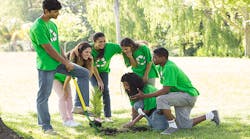Over 1 billion people in 192 countries will take action on Earth Day, April 22, to protect our shared environment. All across the globe, from big cities to small villages and everything in-between, people are organizing, demanding climate action, cleaning up their local communities, meeting with their elected officials, planting trees and teaching their children to protect our planet.
This year, in a rare and special event, United Nations Secretary General Ban Ki-moon has invited every world leader to the United Nations to officially sign the Paris Climate Agreement reached this past December. It is no coincidence that the agreement is being opened for signatures on Earth Day.
“Earth Day is the largest, most recognizable face of the environmental movement,” said Kathleen Rogers, president of Earth Day Network. “Millions of people in dozens of different countries will become lifelong environmentalists this and every Earth Day. Hundreds of thousands will be children – our planet’s future. They will join the more than 1 billion people who already use Earth Day to focus on the urgent need to stabilize and reduce global greenhouse gas emissions, fight climate change, act locally, become climate voters and protect their children’s futures.”
This year, Earth Day Network is focusing on the urgent need to plant new trees and forests worldwide. Throughout the year, EDN sponsors and takes part in tree plantings across the United States. As the four-year count down begins to Earth Day’s 50th anniversary in 2020, Earth Day Network is pledging to plant 7.8 billion trees worldwide – one for every person on Earth.
“We have no higher priority this year than to make sure the United States, China, India, the EU and all the largest CO2 emitters sign the Paris Agreement. EDN has launched a petition calling on world leaders – including President Obama – to show leadership. We need to prove that what happened in Paris last December was not all talk.,” Rogers said.
This year's celebration of Earth Day coincides with the publication of a study in the journal PLOS ONE by a team of researchers at Clemson University, the U.S. Forest Service and Arizona State University who examined the impact of urban parks on city dwellers. The study explored factors associated with residents’ well-being in 44 major cities across the United States.
“Our research suggests parks have a unique capacity to enhance physical health and foster a sense of community,” Lincoln Larson, assistant professor in the Clemson University parks, recreation and tourism management department, told Michael Staton from the university's College of Health, Education and Human Development. “As a result, park quantity, measured as the percentage of city area covered by public parks, was consistently among the strongest predictors of well-being.”
Larson told Staton that it's not just parks but every type of urban green space that matters when it comes to public health and happiness. In a paper published earlier this year in the International Journal of Environmental Research and Public Health, Viniece Jennings of the U.S. Forest Service and Jessica Yun of Georgetown University synthesized a growing body of research examining links between the benefits provided by urban green space and social determinants of health. Their review focused specifically on the cultivation of health equity across diverse populations.
“Parks and green space provide a number of direct and indirect health benefits, yet few researchers have attempted to bridge disciplinary gaps between the ecosystem service and public health frameworks,” Jennings said. “By neglecting those connections, we’re missing the opportunity to advance innovative conversations about urban health, environmental justice and sustainability.”

